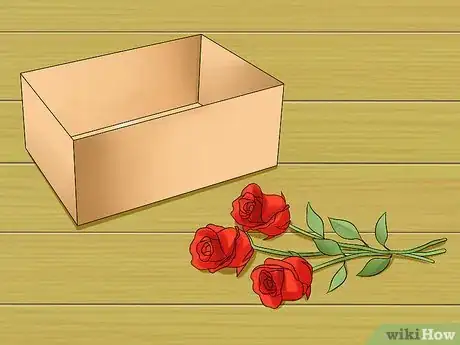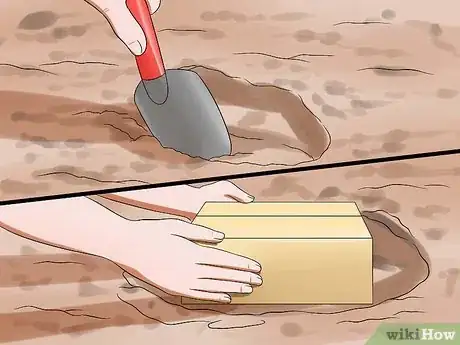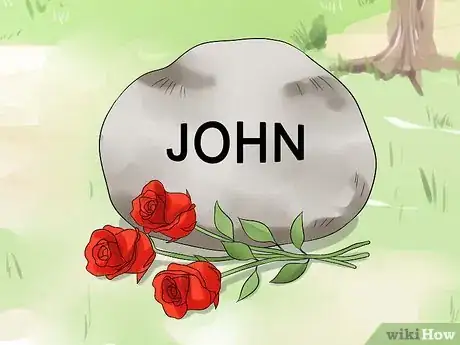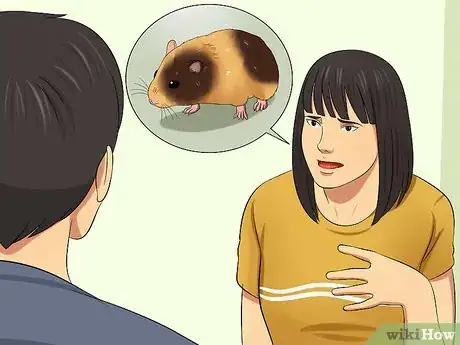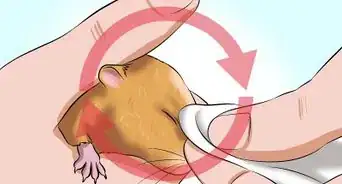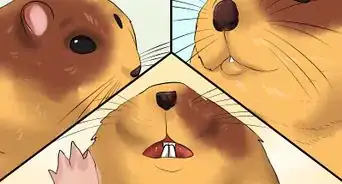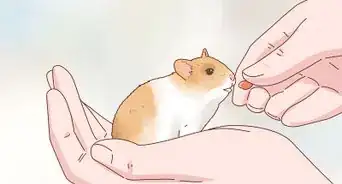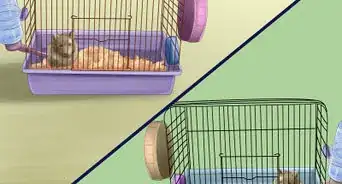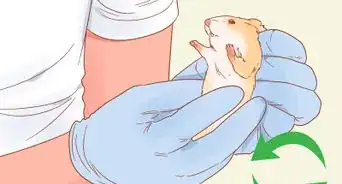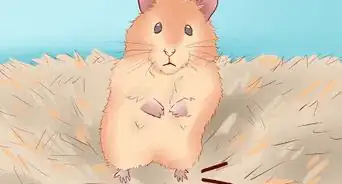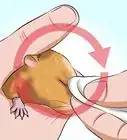This article was co-authored by Adam Dorsay, PsyD. Dr. Adam Dorsay is a licensed psychologist in private practice in San Jose, CA, and the co-creator of Project Reciprocity, an international program at Facebook's Headquarters, and a consultant with Digital Ocean’s Safety Team. He specializes in assisting high-achieving adults with relationship issues, stress reduction, anxiety, and attaining more happiness in their lives. In 2016 he gave a well-watched TEDx talk about men and emotions. Dr. Dorsay has a M.A. in Counseling from Santa Clara University and received his doctorate in Clinical Psychology in 2008.
wikiHow marks an article as reader-approved once it receives enough positive feedback. In this case, 80% of readers who voted found the article helpful, earning it our reader-approved status.
This article has been viewed 159,757 times.
Hamsters are great pets and can easily become good friends over time. Unfortunately, due to their short life span, owners will have to face the loss of their pet. Losing your pet can be a difficult and painful time. However, there are some steps you can take to say goodbye to your hamster and deal with your feelings of loss.
Things You Should Know
- Bury your hamster in a container at least 2 feet (0.61 m) deep so it remains undisturbed.
- Place a grave marker at the site and say a few words if you wish.
- Allow yourself time to grieve the death of your pet.
- Try talking or journaling about your loss to help you cope.
Steps
Burial Ceremony
-
1Prepare for the burial. Before you bury your hamster and do any ceremony you feel appropriate you will need to prepare a few things. Proper preparation can make your ceremony go smoothly and will help you say goodbye to your friend in a meaningful way. Gather the following items to prepare for your hamster's funeral:
- A container for your hamster. Opt for cardboard, cloth or paper containers instead of plastics.
- Personal items for your ceremony such as flowers or candles.
- Something to dig a grave for your hamster.
- A marker for the grave site.
-
2Bury your hamster. After you have found a good site for your hamster to be buried and have collected the materials needed, it is time to bury your hamster. You will need to dig a deep grave for your hamster and fill it in properly to prevent any birds or animals from disturbing it.[1]
- Dig a hole as deep as you can to place your hamster inside of it. Try to dig at least two feet down.
- Once your hamster is inside its container, place the container inside the hole.
- Place stones over the container before filling the top of the hole in with dirt.
Advertisement -
3Place a marker and complete your ceremony. Once you have finished burying your hamster you will want to place a marker. The marker will help you remember exactly where you have laid your hamster to rest. Placing the marker and finalizing your ceremony will help you to say goodbye to your friend and serve as a reminder of your time together.
- Your marker can be something simple, such as a stone that you can place in the ground.
- You can paint, draw, engrave, or carve anything you want to on your hamster's marker.
Dealing With Grief
-
1Experience your grief. Losing a pet can be a difficult and painful time. Many powerful emotions are likely to be experienced during this time and they will need to be worked through. Don't be afraid to experience and process these emotions during the following stages of loss:[2] [3]
- Denial is usually the first feeling to arise during a time of loss, being a kind of disbelief in regards to the loss.
- Anger is a reaction to the pain of loss.
- Bargaining is the phase where someone might start asking “If only...” questions and wondering if they could have saved or prevented the loss in some way.
- Depression is generally felt right before acceptance. It can be a quiet sadness before letting your pet go.
- Acceptance is that final stage where you have fully come to terms and integrated your loss.
-
2Talk about it. It might be tempting to deal with your feelings of loss alone. However, talking about your loss with friends and family can help you share your feelings and work towards accepting the loss. Speak with your family and friends to lessen the pain of losing your hamster. [4]
-
3Try writing down your feelings. After the loss of your hamster, you might want to consider writing your thoughts down. Expressing your feelings by writing after the loss of your hamster can help you understand and work through them during grieving process. Try some of the following written formats that you can use to express your feelings: [5]
- Journaling
- Poetry
- Essay or short stories about your hamsters life.
- Write a eulogy for your hamster that explains how important they were to you.
-
4Take your time. Overcoming the feelings of grief that can come from losing a pet will take different amounts of time for everyone. Don't be in a rush to feel better and allow yourself time to process and come to terms with your loss.[6]
- It can be a good idea to wait before rushing into getting a new hamster.
- There is no hurry or set time line that you must feel better by.
- Listen to yourself and you will know when the time is right for a new hamster.
Community Q&A
-
QuestionWhat should I do if people at school bully me over the loss of my hamster?
 Community AnswerLosing a pet is difficult, and being bullied about it is even more traumatic. Tell an adult or teacher, as they should never allow bullying regardless of the situation. Also, take a moment to tell your loved ones about your feelings. Talking about your grief can help you overcome it.
Community AnswerLosing a pet is difficult, and being bullied about it is even more traumatic. Tell an adult or teacher, as they should never allow bullying regardless of the situation. Also, take a moment to tell your loved ones about your feelings. Talking about your grief can help you overcome it. -
QuestionWhy did my hamster have to die? How do I know if he loved me as much as I loved him?
 Community AnswerAll creatures die eventually, and hamsters in particular have short lifespans. There's nothing that could have been done about it. There's no way to know for sure how your hamster felt about you, but as long as you gave him a good life, he was probably happy to have spent it with you.
Community AnswerAll creatures die eventually, and hamsters in particular have short lifespans. There's nothing that could have been done about it. There's no way to know for sure how your hamster felt about you, but as long as you gave him a good life, he was probably happy to have spent it with you. -
QuestionHow do I remember all the good times I had with a dead pet?
 Community AnswerYou should look back on photos and videos you have of them. Look at things they may chewed on, or played with.
Community AnswerYou should look back on photos and videos you have of them. Look at things they may chewed on, or played with.
Things You'll Need
- Non-plastic container
- Personal items for the ceremony
- Small shovel or hand shovel
- Marker for the grave site
References
- ↑ http://www.letyourlovegrow.com/coping-with-loss/pet-loss-support/burying-a-pet/
- ↑ http://www.humanesociety.org/animals/resources/tips/coping_with_pet_death.html
- ↑ http://psychcentral.com/lib/the-5-stages-of-loss-and-grief/
- ↑ http://www.humanesociety.org/animals/resources/tips/coping_with_pet_death.html
- ↑ http://www.humanesociety.org/animals/resources/tips/coping_with_pet_death.html
- ↑ http://www.humanesociety.org/animals/resources/tips/coping_with_pet_death.html
